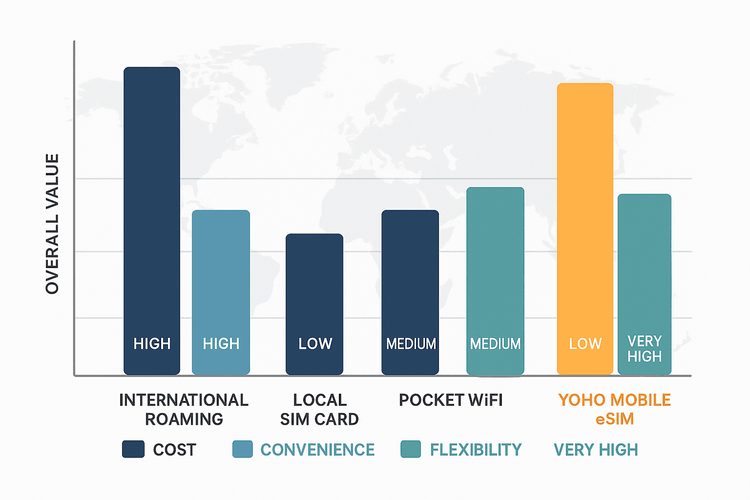Planning an international trip in 2026? Beyond booking flights and hotels, one crucial question remains: how will you stay connected? Navigating the world of international data plans can be a minefield of hidden fees, inconvenient setups, and the dreaded “bill shock.” For years, travelers have juggled international roaming, local SIM cards, and clunky pocket WiFi devices. But a new champion has emerged, offering unparalleled flexibility and affordability.
This guide breaks down the four main options to help you choose the best way to stay online abroad. The right choice can save you hundreds of dollars and significant stress. Ready to discover the future of travel connectivity? You can start by exploring Yoho Mobile’s flexible international eSIM plans today.
The Old Guard: International Roaming
International roaming is the service your home carrier provides that lets you use your phone abroad. It’s the default option for many, automatically kicking in when you land in a new country.
Pros:
- Utmost Convenience: It works the moment you turn off airplane mode. There’s no need to swap SIMs or configure settings. You keep your existing phone number for calls and texts.
Cons:
- Exorbitant Costs: This convenience comes at a steep price. Pay-per-use data rates can be astronomical, and even daily passes are often expensive, costing $10-$15 per day. It’s a primary cause of vacation-ruining phone bills. Learning how to avoid expensive roaming charges in 2026 is a key travel skill that often starts with looking for better alternatives.
- Throttling and Limits: Many roaming plans have strict data caps or will drastically slow your speeds after you’ve used a certain amount of data, making it unreliable for anything more than basic messaging.
The Local Approach: Physical SIM Cards
For decades, the savvy traveler’s go-to has been to buy a local prepaid SIM card upon arrival. You find a kiosk at the airport or a local shop, buy a SIM, and swap it into your phone.
Pros:
- Cost-Effective: Generally much cheaper than roaming, offering better rates for data, calls, and texts within that country.
- Local Number: Useful for making local reservations or for services that require a local contact.
Cons:
- Inconvenience: The hunt for a SIM card after a long flight is a hassle. Language barriers can complicate the purchase and activation process. You also risk losing your tiny home SIM card.
- Single-Country Focus: If your trip spans multiple countries, like a tour of Europe or a backpacking adventure in Southeast Asia, you’ll need to repeat this process in every new location.
- Loss of Home Number: While the local SIM is in, you can’t receive calls or standard texts to your primary number, which can be a problem for two-factor authentication (2FA) messages from your bank.
The Portable Hub: Pocket WiFi Rental
A pocket WiFi is a portable hotspot device you rent before your trip and return afterward. It uses a local SIM to create a personal WiFi network for your devices.
Pros:
- Connect Multiple Devices: A single pocket WiFi can provide internet for your phone, laptop, and tablet simultaneously, which is great for families or groups.
Cons:
- Another Device to Manage: You have to carry, charge, and protect an extra piece of hardware. The battery life can be a concern during long days of sightseeing.
- Rental Hassle: The process of ordering, picking up, and returning the device can be cumbersome. Forgetting to return it or losing it can result in hefty fees.
- Limited Range: You must stay close to the device to remain connected, making it impractical if your group splits up. When considering pocket WiFi vs eSIM for Europe travel, the hassle of a physical device for a multi-country trip becomes a major drawback.
The Modern Solution: Travel eSIM
eSIM (embedded SIM) is a digital SIM card built directly into your phone. It allows you to download and activate a data plan from a provider like Yoho Mobile without needing a physical card. This technology is the clear winner for modern international travel.
Pros:
- Instant Connectivity: Purchase and install your plan from home before you even leave. Your data is ready to use the moment you land.
- Affordable & Transparent: eSIM plans are highly competitive and often the cheapest international data plan for multiple countries. With providers like Yoho Mobile, you pay for exactly the data, country coverage, and duration you need, with no hidden fees.
- Global & Regional Flexibility: Buy a plan for a single country like Japan, a region like Asia, or a global plan covering over 100 countries. Switching plans is as easy as a few taps in an app.
- Keep Your Home Number: Because the eSIM handles your data, your primary physical SIM can remain active for calls and texts. Dual SIM functionality lets you use both simultaneously.
- Enhanced Security: No risk of losing a physical SIM card. If your phone is lost, your eSIM profile cannot be easily removed and used in another device.
With Yoho Mobile, you also get exclusive benefits like Yoho Care, which ensures you’re never left completely disconnected, even if you use up your data allowance. Not sure if it’s for you? You can even try it for free before you commit!

Head-to-Head Comparison: Which Option is Best for You?
To make it simple, here’s a breakdown of how these global connectivity solutions stack up for different types of travelers.
| Feature | International Roaming | Local SIM Card | Pocket WiFi | Yoho Mobile eSIM |
|---|---|---|---|---|
| Cost | Very High | Low-Medium | Medium | Very Low |
| Convenience | Very High | Low | Medium | Very High |
| Multi-Country | Yes (but expensive) | No (very hard) | Yes (can be) | Yes (seamless) |
| Setup Time | None | 15-30 mins | 5-10 mins | < 2 minutes |
| Keep Home Number | Yes | No | Yes | Yes |
- The Business Traveler: Time and reliability are critical. An eSIM is the best choice for instant connection upon landing without the fuss of finding a store.
- The Backpacker: For multi-country trips on a budget, an eSIM is a game-changer. A single regional plan is far more convenient and often cheaper than buying multiple local SIMs.
- The Digital Nomad: An eSIM is a must-have in the toolkit of the best travel sim card for digital nomads. The ability to easily switch between affordable, high-data plans in different countries is unmatched.
- The Family on Vacation: While a pocket WiFi can seem appealing, managing multiple eSIMs on family members’ phones via one account is often simpler and removes the risk of losing a shared device.
Ready to find the perfect plan for your next adventure? Explore flexible data plans with Yoho Mobile.

How to Get Started with Yoho Mobile eSIM
Switching to an eSIM is incredibly simple:
- Check Compatibility: First, ensure your device is on the eSIM compatible list. Most smartphones manufactured since 2018 are supported.
- Choose Your Plan: Visit the Yoho Mobile website and select the destination, data amount, and duration that fits your trip.
- Install Your eSIM: After purchase, you’ll receive instructions. For iOS users, it’s a seamless one-click process—simply tap the ‘Install’ button in the app to add the eSIM to your phone in under a minute, no QR codes or manual entry needed. Android users can quickly install via a QR code.
- Activate on Arrival: Once you arrive at your destination, just switch your mobile data line to your Yoho Mobile eSIM, and you’re instantly connected!
Frequently Asked Questions (FAQ)
Q1: Is an eSIM better than a physical SIM for international travel?
Yes, for most travelers, an eSIM is significantly better. It offers greater convenience (instant activation), flexibility (easy to switch plans and countries), and security. You also get to keep your primary SIM active for calls and texts, which is a major advantage over swapping physical cards.
Q2: What is the cheapest international data plan for multiple countries?
Regional eSIM plans are typically the most cost-effective solution for multi-country travel. Instead of buying a new SIM in each country or paying high daily roaming fees, a provider like Yoho Mobile offers affordable packages covering entire continents like Europe or Asia, saving you money and hassle.
Q3: Can I keep my original phone number when using a travel eSIM?
Absolutely. This is one of the biggest benefits of eSIM technology. Your eSIM will handle your mobile data, while your primary physical SIM (or other eSIM) remains active in your phone, allowing you to make and receive calls and texts on your regular number. You can learn more about the benefits on our blog post about the benefits of eSIM.
Q4: What happens if I run out of data on my Yoho Mobile eSIM?
Don’t worry, you won’t be cut off. Yoho Mobile offers easy manual top-ups directly from our app. Furthermore, our exclusive Yoho Care service provides a safety net, ensuring you always have enough data for essential services like maps and messaging, so you never truly lose connection.
Conclusion: Embrace Smarter Travel in 2026
As we look towards 2026, the way we connect abroad has fundamentally changed. While international roaming, local SIMs, and pocket WiFi still exist, they are relics of a less connected, more complicated era. eSIM technology has emerged as the undisputed best choice for the modern traveler, offering a powerful combination of affordability, convenience, and flexibility.
By choosing an eSIM from Yoho Mobile, you’re not just buying a data plan; you’re upgrading your entire travel experience. Say goodbye to bill shock, airport SIM queues, and extra hardware. Say hello to instant, seamless connectivity the moment you arrive.
Start your journey with a Yoho Mobile eSIM today and travel smarter.
